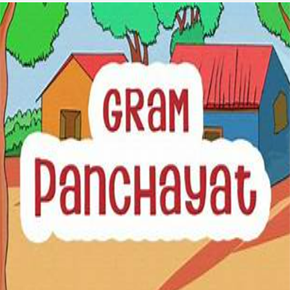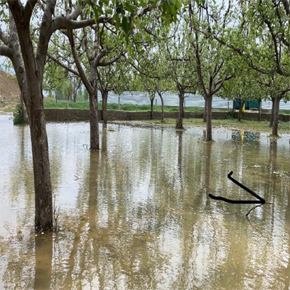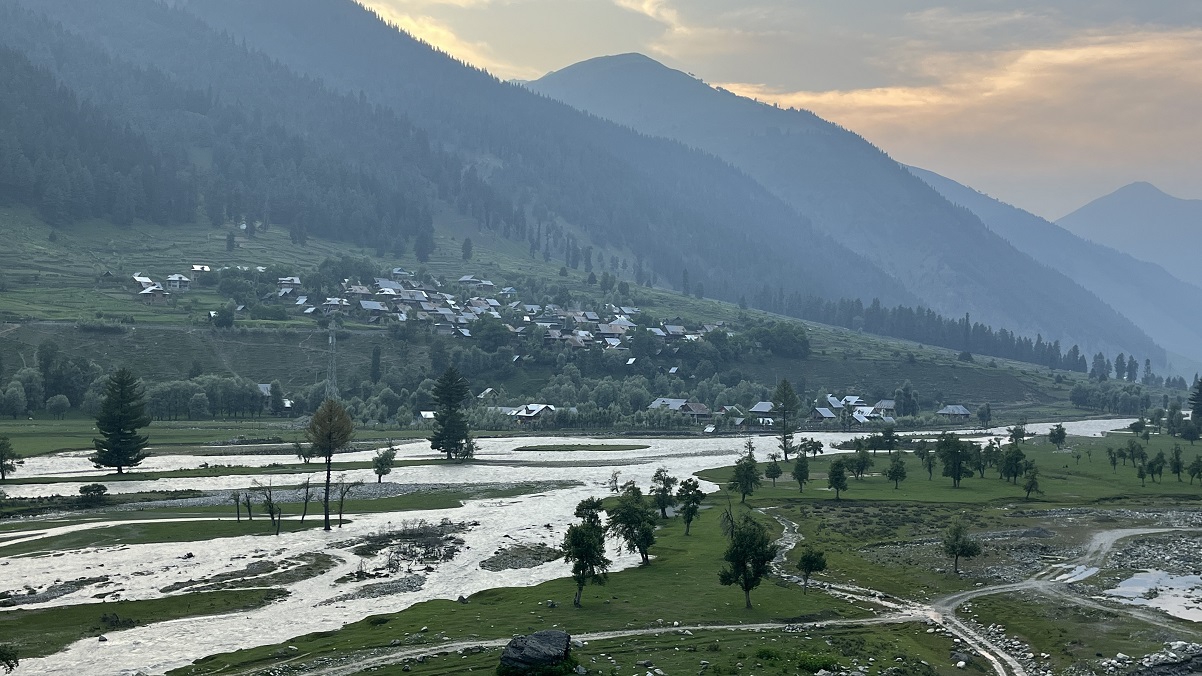Srinagar: On the night of July 30, 2022, at about 9 pm, I spotted a JCB machine extracting sand and gravel from the bed of the Shali Ganga stream in the Lalgund Panzan area of district Budgam.
The Shali Ganga is a small stream that originates in the Tatakoti glacier in the Pir Panjal mountain range as a tributary of the Doodh Ganga, which itself is a tributary of the Jhelum river. This little stream is also the subject of an appeal I filed with the National Green Tribunal (NGT) in May 2022 about what I believe is the illegal grant of environmental clearance (EC) for riverbed mining on the Shali Ganga by the Jammu and Kashmir Environment Impact Assessment Authority (JKEIAA) to a Gurugram-based construction company named NKC Projects Pvt Ltd.
I filed this case with the NGT when, after nearly a year of appealing to various government authorities, including the District Mineral Officer, Budgam, the Sub Divisional Magistrate, Chadoora, and the Secretary, Mining, J&K government, to look into violations of environmental laws by various contractors including NKC Projects Pvt. Ltd, I saw that no action was being taken.
Based on my appeal petition which needed to filed within one month of the project clearance as mandated by the EIAA guidelines, the NGT had given the JKEIAA and NKC Projects a month to reply to my charges that they were violating the regulations of the Jammu and Kashmir Minor Mineral Concession, the Transportation of Minerals and Prevention of Illegal Mining Rules, 2016, and the standard guidelines of the JKEIAA itself.
In response to the notice issued by the NGT, member secretary of the JKEIAA Rakesh Kumar wrote on June 26, 2022, to the Registrar General, National Green Tribunal, denying that the agency’s guidelines were being violated.
On July 29, 2022, NKC Projects Pvt Ltd also wrote to the NGT, denying the charges I made against them. Supported by an affidavit, a copy of which is in my possession, NKC Projects said that the heavy machinery brought to the site was being used merely to create an approach road to the mine and that all mining operations stop at 6 pm.
Yet, on the night of July 30, at about 9 pm, exactly one day after the NGT received the reply and affidavit from NKC Projects Pvt. Ltd that denied all violations, I spotted a JCB machine extracting sand and gravel from the bed of the Shali Ganga.
It seems the problem of illegal mining in the Kashmir valley is set to continue for years.
Machines at midnight
Part of the beauty of the Kashmir Valley comes from the many rivers and streams that arise in the mountains of the Himalayas and the Pir Panjal and flow into the Jhelum river.
Most of these tributaries are less than 50 meters wide. But their waters are used for drinking and to irrigate paddy fields and apple orchards.
In the last 20 years, the combination of massive urbanisation and a population explosion has put pressure on the Jhelum and its tributaries, many of which are being mined for construction material like sand, gravel and boulders regardless of environmental concerns.
While riverbed mining has always been conducted in this area, it was carried out manually by local workers, so the environmental impact was low. However, in the last few years, contractors have been bringing in heavy machines for riverbed mining, which is degrading and destroying these rivers. Since the cost of construction materials has also nearly doubled, locals believe that an organised mining mafia is working across the Kashmir valley, clandestinely backed by officials from several government departments including the geology and mining department, the irrigation and flood control department, and the departments of fisheries, revenue and police.
It is never easy for a project proponent (contractor) to get a river bed mining contract anywhere in the country since there is a long and rigorous process involved in acquiring environmental clearance from the relevant State Environmental Impact Assessment Authority.
In Jammu & Kashmir, the JKEIAA, which works under the direction of the Union Ministry of Environment Forests and Climate Change, is the authority that grants the EC document when the project proponent fulfils several standard and specific conditions. These conditions include the prohibition of mining at night, the prohibition of the use of heavy machinery in mining operations, a provision to sell the excavated material from the riverbed locally at a discount of 50% and the use of CCTVs on the site.
The rigorous process exists for a reason. Already, Kashmir’s paddy land has been destroyed by brick kilns and almond orchards in karewa land (elevated table land) have been wasted due to clay mining. Rivers and streams are unscrupulous contractors’ next target.
Without an environmental impact assessment, no project proponent can undertake riverbed mining. In the case of the Shali Ganga mining site, the EC was granted by the JKEIAA to NKC Project Pvt. Ltd under proposal numbers SIA/JK/MIN/255737/2022 and SIA/JK/MIN/233732/2021 and an order dated April 19, 2022, to undertake riverbed mining on approximately three hectares of riverbed around minor mineral Block No. 4 located between Panzan bridge and Trumbi Bagh, in downstream Shali Ganga. This is located at Lalgam village in Chadoora tehsil of Budgam district.
NKC Project Pvt. Ltd, incidentally, also holds the contract for the Srinagar Semi Ring Road.
When the NGT heard my appeal against the JKEIAA and NKC Project Pvt. Ltd, my counsel Rahul Chowdhary argued that the EC granted by JKEIAA was in violation of Rule 4(iv) of the Jammu and Kashmir Minor Mineral Concession which states that the licensee of a unit/plant/crusher should maintain all records of the minor minerals procured, processed and supplied to further destinations and submit monthly returns.
Chowdhary added that Rule 4 of the J&K Mining Rules, 2016, is also being violated as it prohibits mining within 25 meters from the embankments. Since the widths of the Doodh Ganga and Shali Ganga streams are no more than 40 meters on an average, it seems that no verification of the width of the streams was made on ground. Thus, it is illegal to allow mining in their riverbeds.
When the court issued a one-month notice to the JKEIAA and NKC Project Pvt. Ltd, the JKEIAA responded within two days, stating that the rule regarding distance from the embankments had been amended, reducing it to 10 metres on either side. Even with this new parameter in place however, the fact remains that the mining is being carried out just two to three metres away from the embankments.
A muddy future
The riverbeds of the Doodh Ganga and the Shali Ganga in Budgam district are already over-exploited and unfit for mining. Any further mining will result in a disruption of water flow, which will impact the Hokersar wetland, a designated bird sanctuary just 10 km from Srinagar.
In fact, the Hokersar wetland has already been impacted by the deep mining in the Shali Ganga and the Doodh Ganga. Silt has begun to accumulate in the area due to the muddy water brought to it by the Shali Ganga and the Doodh Ganga, which is the result of the deep mining of the riverbeds. When it rained heavily between June 18 and 21 this year, the water level in the Doodh Ganga increased to such an extent that it caused soil erosion. The main reason for this soil erosion is that the illegal deep mining has weakened the embankments of the river. The erosion in some places was so bad that there were even landslides. Had it rained for one more day, the local government degree college in Chadoora could well have been washed away.
Meanwhile, the muddy water filled with solid and liquid waste constantly provided to the Hokersar wetland by the Doodh Ganga is beginning to degrade the bird sanctuary.
“Hokersar is the abode of different species of birds that come all the way from Europe and Russia every winter,” local birdwatcher Rayan Sofi told me. “As the water level in Hokersar decreases, the visiting bird numbers also decrease.”
“Hokersar is designated a wetland site of international importance under the Ramsar Convention of 1971, and is also known as the Queen of Wetlands. But the queen is on her death bed because Hokersar constantly gets silt and solid waste from the Doodh Ganga,” says Javaid Sofi, an environmental activist and a resident of Zainakot village located on the eastern shore of Hokersar wetland.
For Raashid Naqash, Regional Wildlife Warden, Kashmir, siltation in the Doodh Ganga is a big problem that the government needs to address urgently. In fact, the wildlife warden wrote a letter to the District Mineral Officer, Budgam, and the Flood Control department, in July, asking them to regulate mining according to the rules of the Wildlife Protection Act 1972, the Environmental Protection Act 1986 and the Wetland Conservation Rules 2017.
Part of the problem is the fact that no replenishment study has been conducted as demanded by the Enforcement & Monitoring Guidelines for Sand Mining, 2020. In fact, the entire tendering process is flawed.
“How can NKC Projects Pvt. Ltd extract sand, muck and gravel and use it for its Ring Road project when the Mining Rules 2016 and JKEIAA guidelines say that any material extracted has to be sold locally within a radius of two km at a discount of 50%?” asks Badrul Duja, a public interest lawyer from Srinagar.
He adds: “The rules also say that the mining work should be done manually by local labourers so that they earn a livelihood. But in Shali Ganga and Doodh Ganga, the material is extracted by heavy machines and then is supplied to big stone crushing units from where the local population is sold the same material at exorbitant rates. A few years ago, a truckload of sand was sold for Rs 3,500. Today the price is Rs 12,000 or more. Again, the rules say the excavations can only be one meter deep, but the heavy machines used by the project proponents go as deep as 10 meters. Last month in Reasi and Budgam districts, three people drowned in the deep trenches dug by these machines. This is injustice, looting of our natural resources, and an environmental disaster.”
Call to action
A petition I had filed in the NGT the previous year regarding illegal mining and the dumping of solid and liquid waste in the Doodh Ganga resulted in an order in March 2022 that imposed a penalty of Rs 3 crores on various government departments.
Since this order, the government has started taking action. For example, the solid waste management programme and treatment of sewage is being taken up by the J&K Urban Environment Engineering Department, which has sanctioned Rs 149 crores to set up Sewerage Treatment Plants on the banks of the Doodh Ganga.
Meanwhile, the State Pollution Control Board, which is called the Pollution Control Committee (PCC) in J&K, was directed by the NGT to recover penalty money from the Geology & Mining Department as environmental compensation. Although four months have passed since the NGT’s order, the compensation is yet to be recovered. However, according to Ramesh Kumar, secretary of the PCC, told me Regarding the Shaili Ganga case, I took a video and photographs of the machine excavating material on the night of July 30 and brought them to the attention of O.P. Bhagat, the director of the Geology and Mining department, as well as Dr Ghulam Din, the district mineral officer, Budgam, and the Secretary, Mining.
Though none of these officials responded, I have filed a reply to NKC Projects Pvt Ltd’s denial of violations in the NGT.that his organisation was in the process of recovering it. The case will be heard again in a few days. I have every hope that the agencies involved in illegal mining on the Shali Ganga will be penalised.

























































































